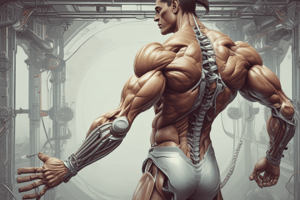Podcast
Questions and Answers
What are Lever Systems?
What are Lever Systems?
Lever Systems are the coordination of our bones and muscles, primarily to create human movement.
What are the two main functions of Lever Systems?
What are the two main functions of Lever Systems?
- To increase the speed of a given movement (correct)
- To generate muscular effort to overcome a given load (correct)
- To reduce muscle fatigue
- To create static balance
Define Fulcrum in the context of a lever system.
Define Fulcrum in the context of a lever system.
Fulcrum is the point around which the lever rotates (the pivot). In the body, the fulcrum is the joint where the movement is occurring.
Define Effort in the context of a lever system.
Define Effort in the context of a lever system.
Define Load in the context of a lever system.
Define Load in the context of a lever system.
Define Lever in the context of a lever system.
Define Lever in the context of a lever system.
In all three class levers, is the Fulcrum always below the Lever Arm?
In all three class levers, is the Fulcrum always below the Lever Arm?
On a First (1st) Class Lever, is the Effort pointing upwards above the Lever Arm?
On a First (1st) Class Lever, is the Effort pointing upwards above the Lever Arm?
On a Second (2nd) and Third (3rd) Class Lever, is the Effort pointing downwards above the Lever Arm?
On a Second (2nd) and Third (3rd) Class Lever, is the Effort pointing downwards above the Lever Arm?
What does FLE stand for in lever systems?
What does FLE stand for in lever systems?
What shape is the Fulcrum shown as when drawing a lever system?
What shape is the Fulcrum shown as when drawing a lever system?
How is Effort depicted in a lever system drawing?
How is Effort depicted in a lever system drawing?
What shape is Load depicted as when drawing a lever system?
What shape is Load depicted as when drawing a lever system?
What shape is a Lever depicted as when drawing a lever system?
What shape is a Lever depicted as when drawing a lever system?
What determines the class of lever?
What determines the class of lever?
Define a First Class Lever.
Define a First Class Lever.
What is the diagram of a First Class Lever like?
What is the diagram of a First Class Lever like?
What is a First Class Lever similar to?
What is a First Class Lever similar to?
List three examples of First Class Levers in the body.
List three examples of First Class Levers in the body.
Describe Rowing a Boat as a First Class Lever.
Describe Rowing a Boat as a First Class Lever.
Describe Heading a Football as a First Class Lever.
Describe Heading a Football as a First Class Lever.
Describe Throwing a Javelin as a First Class Lever.
Describe Throwing a Javelin as a First Class Lever.
Define a Second Class Lever.
Define a Second Class Lever.
What is the diagram of a Second Class Lever like?
What is the diagram of a Second Class Lever like?
Flashcards are hidden until you start studying
Study Notes
Lever Systems Overview
- Lever Systems coordinate bones and muscles to facilitate human movement.
- Key functions include generating muscular effort to overcome loads and increasing movement speed.
Components of Lever Systems
- Fulcrum: The pivot point around which the lever rotates; in the body, it is the joint where movement occurs.
- Effort: The force exerted by the user of the lever system; in the body, this comes from muscle contractions.
- Load: The weight of the object or body part being moved; the force applied by the lever system.
- Lever: The bone that acts as the arm of the lever system.
Lever Arm Configuration
- In all three classes of levers, the fulcrum is always positioned below the lever arm, while both load and effort are positioned above it.
Types of Levers
- First Class Lever: Fulcrum in the middle, with effort pushing downwards above the lever arm.
- Second Class Lever: Load in the middle, with effort pulling upwards.
- Third Class Lever: Effort is in the middle, also pulling upwards.
Representing Lever Systems
- Components are represented with specific shapes:
- Fulcrum as a triangle.
- Effort as an arrow, indicating the direction of force.
- Load as a square.
- Lever as a straight line.
- The arrangement of these components determines the class of the lever.
First Class Lever Details
- A First Class Lever has the fulcrum between the load and effort.
- Diagram components indicate the load pushes down, fulcrum is centrally located, and effort is applied downwards.
- Analogous to a seesaw.
- Examples in the body include:
- Rowing a boat.
- Heading a football.
- Throwing a javelin.
First Class Lever Applications
-
Rowing a Boat:
- Fulcrum at the pivot point of the oar.
- Effort from the rower's arm and back muscles.
- Load is the paddle end pushing the water.
-
Heading a Football:
- Fulcrum located at the neck joint.
- Effort from the footballer's neck and back muscles.
- Load is the footballer's head.
-
Throwing a Javelin:
- Fulcrum at the elbow joint.
- Effort from the biceps and triceps.
- Load is the javelin being thrown.
Second Class Lever Overview
- A Second Class Lever positions the load between the fulcrum and the effort.
- Diagram indicates effort pulls up while the load pushes down.
Applications of Levers
- Understanding lever types is essential for analyzing human biomechanics and optimizing performance in sports and physical activities.
Studying That Suits You
Use AI to generate personalized quizzes and flashcards to suit your learning preferences.




